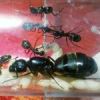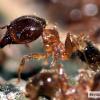I'm pretty sure this species has made it to the coast of North Carolina, I have witnessed them there along the beach in summer and in some coastal cities maybe surviving the winter indoors?
There are many areas much farther North than you that Pheidole megacephala are known to be indoor-introduced. Maryland, for example. However, with these findings, it is difficult to tell if the species even survives there year-round, or if they just happened to have made it there in the summer and survive until winter. Even if they are surviving year-round, their range and population will be absolutely tiny and insignificant.
If they are surviving outdoors, you are the first person to find them anywhere near that far north in the western hemisphere. The farthest north their range is known to extend, globally, is in a southern town in Western Turkey. It's strikingly cold there for this species, but even then, the daytime high rarely drops below 50F, and night time temps typically don't go below freezing, only for small amounts of time if they do. Comparing this climate to Charlotte, one of NC's warmest, Charlotte is still significantly colder. The average low for January is 32F, exactly freezing. I don't want to say it's impossible, but if this species is indeed present in NC, they likely wouldn't be thriving and merely surviving.
I also urge you to keep in mind, Pheidole is an incredibly diverse genus. Many species of Pheidole are present in NC, some native.
Currently Keeping:
Trachymyrmex septentrionalis
Pheidole pilifera
Forelius sp. (Monogynous, bicolored) "Midwestern Forelius"
Crematogaster cerasi
Pheidole bicarinata
Aphaenogaster rudis
Camponotus chromaiodes
Formica sp. (microgena species)
Nylanderia cf. arenivega




















